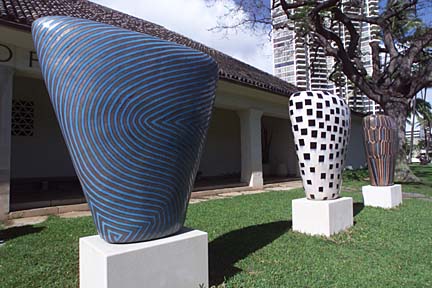

[ MAUKA-MAKAI ]

ON THE AFTERNOON Jun Kaneko was scheduled to greet the A-list guests at a private reception for his latest art exhibition, he missed the chance to meet his newest fan. Ceramist embraces
childlike wondermentGALLERY
By Suzanne Tswei
Star-BulletinFive-year-old Nathan N., walking by the Honolulu Academy of Arts, became captivated by the three gargantuan Kaneko ceramic sculptures on the front lawn. He let out a squeal, clapped his hands and bounced up and down. Then he rushed forward to try to hug one, much to the distress of the adults around him.
Nathan had no idea that he should not touch "art" or that it was created by an internationally important ceramist whose first Hawaii exhibit marks the opening of the academy's new Henry R. Luce Pavilion Complex. Nathan just knew he liked what he saw and it made him happy.
Only an hour earlier inside the museum, Kaneko happened to be lamenting the fact that many adults have lost the faculties to appreciate art.
"A lot of people think they should behave a certain way. They think they should see art a certain way. But if they just open themselves up and just like what they see, that's enough," Kaneko said.
Recent Ceramic Sculptures and Drawings by Jun Kaneko: TROPICAL ENERGY
On display: Through July 22 at the Honolulu Academy of Arts
Hours: Noon to 5 p.m. today, 10 a.m. to 4:30 p.m. Tuesdays through Saturdays, and 1 to 5 p.m. Sundays
Cost: $7; $4 for seniors, students and military; free to members and children. Free admission on the first Wednesday of each month and during next weekend's celebration of the opening of the Henry R. Luce Pavilion.
Call: 532-8700
Sounds easy, but it's not. Education has spoiled our ability to respond to art honestly, intuitively and spontaneously, he said.
"When adults look at art, they come with so much baggage. They bring with them what they learned in school, what they are told art is, what they think they should feel about art, how they should behave. They have all these preconceived ideas in their heads.
"Most people, if they like something, they feel that's not reason enough. It's not adult enough, it's not good enough. They think there must be a better reason, because it's art," Kaneko said.
When people see his work, they become overly impressed by the size, he said. Kaneko is best known for his huge and colorful ceramic sculptures, which he names simply dango, or "dumpling" in Japanese. The word connotes a round shape, and that's why he uses it for all his round pieces, although some are elongated and some are more triangular.
Each sculpture weighs several tons and is built slowly by hand -- going up a maximum of 12 inches a day to allow for proper drying of the clay. A piece takes nine months to dry, nine days for bisque firing and nine days for glaze firing.

The academy is showing three sculptures on the front lawn, three ball-shape sculptures in the courtyard and four elongated pieces at the pavilion complex. Patrons have been so impressed by the sculptures that a word-of-mouth campaign has raised enough money to purchase three pieces at the pavilion.In a small ground-floor gallery, there is a huge wall of 184 ceramic tiles marked with bold geometric and round patterns. To complement the wall sculpture, Kaneko has four ceramic tiles that work as individual paintings, a smaller dango sculpture and drawings inspired by Kauai, where he has spent winter for six years.
Kaneko, who is based in Omaha, Neb., began wintering in Hawaii after a viral disease left him paralyzed. He has recovered well enough to continue working.
His works are in the collections of the State Foundation on Culture and the Arts, which commissioned him for an installation at the entry to the Waikiki Aquarium, Contemporary Museum, Philadelphia Museum of Art, Detroit Institute of Art, American Crafts Museum in New York City and numerous public places.
Born in Nagoya, Japan, in 1942, Kaneko became interested in art when he was a teenager because he was "bored to death" by school, he said. His parents, both dentists, allowed him to rebel against the norm.
He moved to Los Angeles in the early 1960s and began working with ceramics. He made his first dango pieces in the mid-1980s after moving to Omaha.
When he creates a sculpture, he evaluates all visual aspects of the piece, but his consideration is to do what pleases him without regard to potential viewers or his place in art history.
"My work is abstract. The images are my reaction to what I see, what I do, my sense toward my environment. I can't explain it. Making art is a reflection of who you are, what you are thinking."
By the same token, the viewer brings his or her influences and state of mind to the art. All Kaneko asks for, he said, is that viewers open themselves up to new challenges.
Click for online
calendars and events.